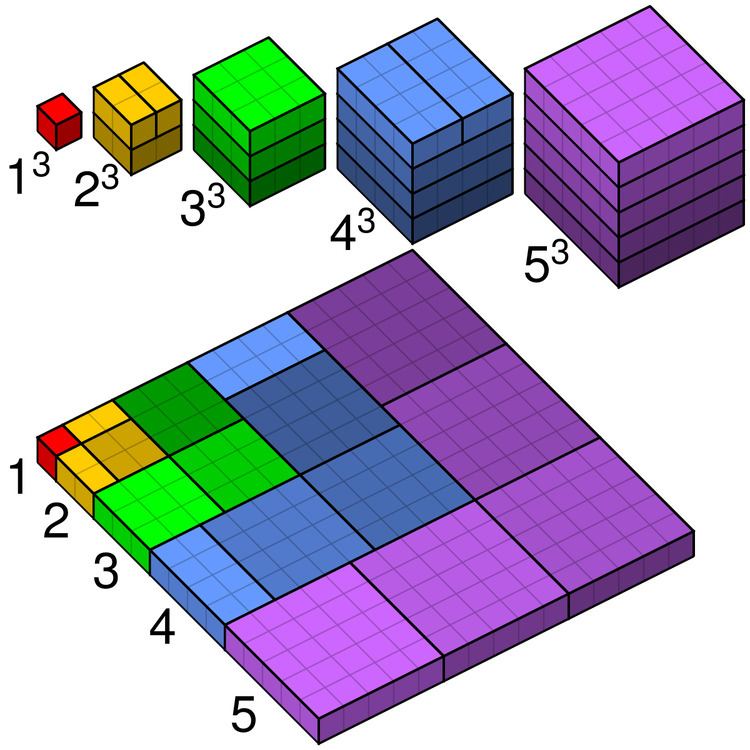 | ||
In number theory, the sum of the first n cubes is the square of the nth triangular number. That is,
Contents
The same equation may be written more compactly using the mathematical notation for summation:
This identity is sometimes called Nicomachus's theorem.
History
Many early mathematicians have studied and provided proofs of Nicomachus's theorem. Stroeker (1995) claims that "every student of number theory surely must have marveled at this miraculous fact". Pengelley (2002) finds references to the identity not only in the works of Nicomachus in what is now Jordan in the first century CE, but also in those of Aryabhata in India in the fifth century, and in those of Al-Karaji circa 1000 in Persia. Bressoud (2004) mentions several additional early mathematical works on this formula, by Alchabitius (tenth century Arabia), Gersonides (circa 1300 France), and Nilakantha Somayaji (circa 1500 India); he reproduces Nilakantha's visual proof.
Numeric values; geometric and probabilistic interpretation
The sequence of squared triangular numbers is
0, 1, 9, 36, 100, 225, 441, 784, 1296, 2025, 3025, 4356, 6084, 8281, ... (sequence A000537 in the OEIS).These numbers can be viewed as figurate numbers, a four-dimensional hyperpyramidal generalization of the triangular numbers and square pyramidal numbers.
As Stein (1971) observes, these numbers also count the number of rectangles with horizontal and vertical sides formed in an n × n grid. For instance, the points of a 4 × 4 grid (or a square made up of three smaller squares on a side) can form 36 different rectangles. The number of squares in a square grid is similarly counted by the square pyramidal numbers.
The identity also admits a natural probabilistic interpretation as follows. Let X, Y, Z, W be four integer numbers independently and uniformly chosen at random between 1 and n. Then, the probability that W be the largest of the four numbers is equal to the probability that both Y is at least as large as X and W is at least as large as Z, that is, P({max(X,Y,Z) ≤ W}) = P({X ≤ Y} ∩ {Z ≤ W}). Indeed, these probabilities are respectively the left and right sides of the Nichomacus identity, normalized to make probabilities by dividing both sides by n4.
Proofs
Charles Wheatstone (1854) gives a particularly simple derivation, by expanding each cube in the sum into a set of consecutive odd numbers. Indeed, he begins by giving the identity
That identity is related to triangular numbers
and thus the summands forming
we obtain the following derivation:
In the more recent mathematical literature, Stein (1971) uses the rectangle-counting interpretation of these numbers to form a geometric proof of the identity (see also Benjamin, Quinn & Wurtz 2006); he observes that it may also be proved easily (but uninformatively) by induction, and states that Toeplitz (1963) provides "an interesting old Arabic proof". Kanim (2004) provides a purely visual proof, Benjamin & Orrison (2002) provide two additional proofs, and Nelsen (1993) gives seven geometric proofs.
Generalizations
A similar result to Nicomachus's theorem holds for all power sums, namely that odd power sums (sums of odd powers) are a polynomial in triangular numbers. These are called Faulhaber polynomials, of which the sum of cubes is the simplest and most elegant example.
Stroeker (1995) studies more general conditions under which the sum of a consecutive sequence of cubes forms a square. Garrett & Hummel (2004) and Warnaar (2004) study polynomial analogues of the square triangular number formula, in which series of polynomials add to the square of another polynomial.
